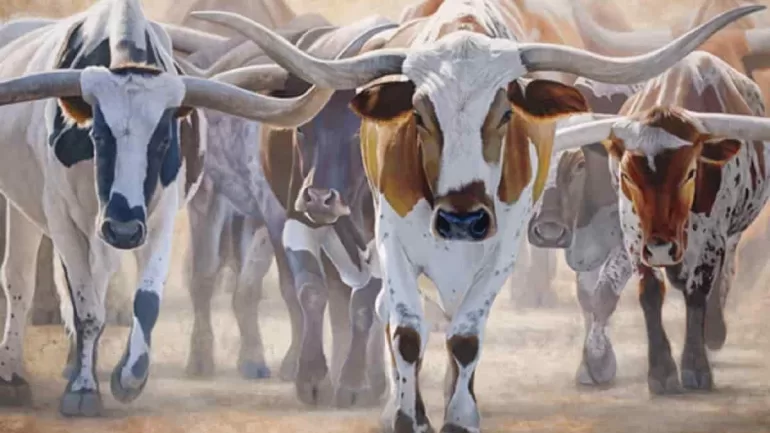ART & DESIGN
The Heart of Chisholm Trail II by James Corwin is an example of human art. The artist contends that in the AI Art vs Human Art fight, human art will win. Image courtesy of the artist.
Will AI replace artists? Find out why an artist believes the competition between AI art vs human art proves that original works are becoming more precious.
BY KAZEEM ADELEKE, ARTCENTRON
HAMILTON, MONTANA—The market for AI art vs human art is at a tipping point. With sales of AI-generated art projected to soar to nearly $19 billion by 2030, a seismic shift is underway in the creative world. This explosive growth raises a critical question for artists and collectors alike: In a world of instantly generated digital “masterpieces,” what happens to the value of original, human-made art?
James Corwin’s Take on AI Art vs Human Art
James Corwin, a renowned wildlife artist and gallery owner in Hamilton, Montana, has a refreshing perspective. Representing over 30 artists across the U.S., Corwin believes the rise of AI doesn’t threaten human creativity; instead, it enhances the appreciation for it. He states, “A lot of people are worried—and they should be—about AI replacing jobs in creative fields. But for fine artists, I think it actually strengthens the demand for genuine, hand-crafted pieces.”
The Enduring Value of the Human Touch
For Corwin, the value of art lies in interaction. He argues that art is more than a product; it’s an emotional experience that can’t be replicated. “Live theater and concerts still draw crowds,” he notes. “That in-person interaction can’t be replicated by machines.”
The artist contends that unique brushstrokes, the subtle texture of paint, and even the artist’s fingerprints in a sculpture are tangible proofs of the human touch. For him, these imperfections are not flaws—they are a testament to the creative process, a quality that separates AI art vs human art, and something AI, no matter how advanced, cannot imitate.
Transparency in the Creative Process
As AI becomes more convincing, authenticity matters more than ever in the debate of AI art vs human art. Corwin suggests that artists should open up their creative process to the public. “When people see the journey from blank canvas to final piece, they believe in the art,” he explains. By involving audiences and documenting their process, artists can showcase the authenticity of their work. This transparency builds trust and fosters a deeper appreciation, a key differentiator when considering AI-generated art.
AI: A Creative Ally, Not a Competitor
Corwin isn’t against AI entirely. In fact, he sees its value as a helpful resource. “I wish I knew how to use AI to create mockup images for painting references,” he admits. Artists are already adopting AI in subtle ways—enhancing ideas, planning compositions, or generating references. The key is honesty. As long as there’s clarity about how the work is produced, AI can be a creative ally, not a competitor.
Creativity Isn’t Going Anywhere
Ultimately, while artificial intelligence will continue to evolve, it lacks the one thing that gives art its true power: lived experience, emotion, and personal expression. As the market fills with flawless, algorithmically-generated images, the raw, imperfect beauty of a human-made creation will only become more precious. This isn’t the end for original art—it’s a new beginning that defines the future of AI art. Original art isn’t dying; it’s becoming more precious.
What do you think about the AI art vs human art debate? Share your thoughts. Leave a comment.
